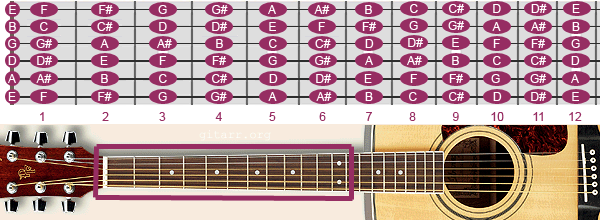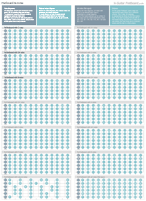Fretboard with notes
The fretboard (also called fingerboard) is the top part of the neck on the guitar, between the body and the headstock. On the diagram below you can learn all the notes on the guitar fretboard – after the 12th fret it's all repeating (the 13th fret is the same as the 1st, only one octave higher).
It's important for your development as a guitar player to learn the position of every note. This helps the understanding of chord theory and makes it easier to play melodies, solos and arpeggios.
The fingerboard map diagram starts with the open strings, when continues with the notes on fret 1 to 12.

The fretboard on the guitar illustrated. From the 12th fret, it's all repeating again.
Digital poster:

Check out and download
In the fretboard diagram, sharps (#) are used and not flats (b). If you for example are looking for the note Ab (A flat) this is the same as G# (G sharp). Notice also how the fret spacing decreases in direction to the body.
The notes on each fret
This is an overview of the frets and the notes on each. Notice that string 1 is the thinnest string.
Fret 1
- String 1 – F
- Sting 2 – C
- String 3 – G#
- String 4 – D#
- String 5 – A#
- String 6 – F
Fret 2
- String 1 – F#
- Sting 2 – C#
- String 3 – A
- String 4 – E
- String 5 – B
- String 6 – F#
Fret 3
- String 1 – G
- Sting 2 – D
- String 3 – A#
- String 4 – F
- String 5 – C
- String 6 – G
Fret 4
- String 1 – G#
- Sting 2 – D#
- String 3 – B
- String 4 – F#
- String 5 – C#
- String 6 – G#
Fret 5
- String 1 – A
- Sting 2 – E
- String 3 – C
- String 4 – G
- String 5 – D
- String 6 – A
Fret 6
- String 1 – A#
- Sting 2 – F
- String 3 – C#
- String 4 – G#
- String 5 – D#
- String 6 – A#
Fret 7
- String 1 – B
- Sting 2 – F#
- String 3 – D
- String 4 – A
- String 5 – E
- String 6 – B
Fret 8
- String 1 – C
- Sting 2 – G
- String 3 – D#
- String 4 – A#
- String 5 – F
- String 6 – C
Fret 9
- String 1 – C#
- Sting 2 – G#
- String 3 – E
- String 4 – B
- String 5 – F#
- String 6 – C#
Fret 10
- String 1 – D
- Sting 2 – A
- String 3 – F
- String 4 – C
- String 5 – G
- String 6 – D
Fret 11
- String 1 – D#
- Sting 2 – A#
- String 3 – F#
- String 4 – C#
- String 5 – G#
- String 6 – D#
Fret 12
- String 1 – E
- Sting 2 – B
- String 3 – G
- String 4 – D
- String 5 – A
- String 6 – E
The 13th fret repeats the notes on the 1st fret.
Learning the fretboard – note location
Memorizing the fretboard will take some time. An easy way to start is to recognize repeating patterns and first of all learn some notes to use a reference. For example, when you know that the lowest string on the fifth fret is A, you could find another A note two strings up and to frets to the right. The same method can be used for the fifth and third strings. For example, when you know that the second lowest string on the fifth fret is D you could find another D note two strings up and to frets to the right. Keep looking at the note locations and you will find more patterns.
Fretboard note location exercise (pdf)
On the first 12 frets you could find all of the notes on six positions, one for each string. The guitar differ from the piano in the way notes of the same pitch can be played at several different positions.
An observation to do is the comparison with notes on open string and the fifth fret. On the fifth string, each note is one position lower (with the jump from second to third as an exception). This relation depends on the fact that the guitar is tuned in 5th intervals: E to A, A to D and so on.
A tip for learning fretboard by routines is to play from notes (sheet music). This forces you to think in terms of notes names and by reference to positions on the fretboard. (An online resource with free sheet music for guitar is Traditionalsongs.org.)
If you really want to learn the fretboard, see The Guitar Fretboard ebook with graphics, playing examples and more.
The story behind the dots
Between some of the frets there are inlays, most often displayed with dots. The function of these is to help you orient in a horizontal direction and make it easier to find the right fret fast. The inlays on the fretboard are placed in a schematic way on the guitar and the typical formation involves single dots on the 3rd, 5th, 7th, 9th, 15th, 17th, 19th and 21st frets and double dots on the 12th and 24th frets.
The reason for double frets on 12th and 24th frets is because the notes start over on these frets. The notes on the 12th fret are one octave higher than on the open strings, and the notes on the 24th fret are one octave higher than the notes on the 12th fret.
Pitches
How many notes that there are on the guitar vary depending on the numbers of frets – all guitars don’t have the same amounts of frets. Also, it’s more correct to talk about pitches, there is after all only twelve unique notes which repeats over many octaves.
Electric guitars, for example, have between 21 and 24 frets, and they will therefore have between
126 and 144 pitches. (The calculation is simple, just multiply the numbers of frets with six.)
Octaves
On the guitar fretboard, same notes are represented many times, but in different octaves. The C note, for example, is represented six times on the first twelve frets. If we start counting from the left on the lowest string, the first two C notes are in one octave, the next three are in a second octave and the last in a third octave.
If you find it very difficult to learn all the notes on the fretboard, you should at least start by learning the tones on the low E and the A strings because the roots of chords are often on these strings. And as you can observe, the lowest and the highest strings are identical.
Fretboard note decals
If you still are uncertain, there are ways to get around. For example, you could tape some notes on the side of the guitar neck or, if you want it to be a little fancier, you could use special made note decals as in the picture below.
